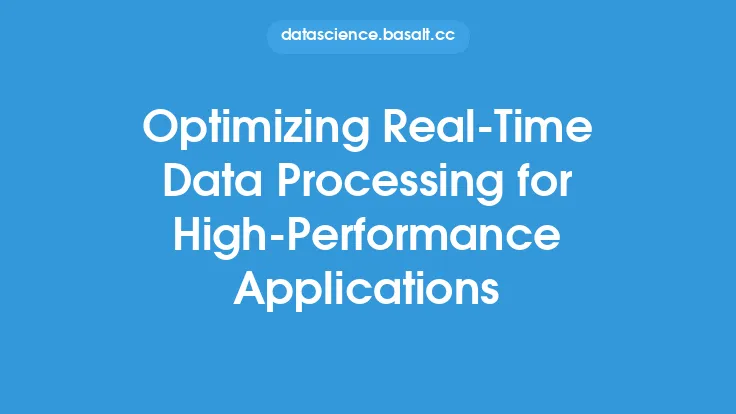Data storage is a critical component of any data engineering system, as it directly impacts the efficiency and effectiveness of data retrieval. When data is stored in an optimized manner, it can be retrieved quickly and easily, allowing for faster analysis, processing, and decision-making. In this article, we will explore the key principles and techniques for optimizing data storage to improve data retrieval.
Understanding Data Retrieval Patterns
To optimize data storage for improved data retrieval, it is essential to understand the data retrieval patterns of your application or system. This includes identifying the types of data that are accessed most frequently, the frequency of access, and the patterns of data retrieval. By understanding these patterns, you can design a data storage system that is optimized for the specific needs of your application. For example, if your application requires frequent access to a specific set of data, you can store that data in a faster, more accessible storage medium, such as solid-state drives (SSDs) or in-memory storage.
Data Storage Architecture
The data storage architecture refers to the overall design and organization of the data storage system. A well-designed data storage architecture can significantly improve data retrieval performance. There are several key components to consider when designing a data storage architecture, including data partitioning, data replication, and data caching. Data partitioning involves dividing large datasets into smaller, more manageable pieces, which can be stored on separate storage devices or nodes. Data replication involves duplicating data across multiple storage devices or nodes to improve availability and reduce the risk of data loss. Data caching involves storing frequently accessed data in a faster, more accessible storage medium, such as RAM or SSDs.
Data Compression and Encoding
Data compression and encoding are techniques used to reduce the size of data and improve storage efficiency. Data compression algorithms, such as gzip or lz4, can be used to compress data, reducing the amount of storage space required. Data encoding techniques, such as run-length encoding (RLE) or Huffman coding, can be used to encode data in a more compact form. By reducing the size of data, compression and encoding can improve data retrieval performance by reducing the amount of data that needs to be transferred and processed.
Indexing and Query Optimization
Indexing and query optimization are critical components of any data storage system. Indexing involves creating data structures that allow for fast lookup and retrieval of data. Query optimization involves optimizing the queries that are used to retrieve data, to minimize the amount of data that needs to be scanned and processed. There are several types of indexing techniques, including B-tree indexing, hash indexing, and bitmap indexing. Query optimization techniques include query rewriting, query caching, and query parallelization.
Storage Media and Hardware
The choice of storage media and hardware can significantly impact data retrieval performance. There are several types of storage media, including hard disk drives (HDDs), solid-state drives (SSDs), and flash storage. HDDs are traditional storage devices that use spinning disks and mechanical heads to read and write data. SSDs are faster, more modern storage devices that use flash memory to store data. Flash storage is a type of storage that uses flash memory to store data, and is often used in high-performance applications. The choice of storage media and hardware will depend on the specific needs of your application, including the required level of performance, capacity, and reliability.
Data Layout and Organization
The data layout and organization refer to the way in which data is stored and organized on disk. A well-designed data layout and organization can significantly improve data retrieval performance. There are several key considerations when designing a data layout and organization, including data striping, data mirroring, and data fragmentation. Data striping involves dividing data into smaller pieces and storing them across multiple storage devices or nodes. Data mirroring involves duplicating data across multiple storage devices or nodes to improve availability and reduce the risk of data loss. Data fragmentation involves breaking up large datasets into smaller, more manageable pieces, which can be stored on separate storage devices or nodes.
Conclusion
Optimizing data storage for improved data retrieval is a critical component of any data engineering system. By understanding data retrieval patterns, designing a well-optimized data storage architecture, using data compression and encoding, indexing and query optimization, choosing the right storage media and hardware, and designing a well-organized data layout, you can significantly improve data retrieval performance. By following these principles and techniques, you can design a data storage system that is optimized for the specific needs of your application, and that provides fast, efficient, and reliable data retrieval.





